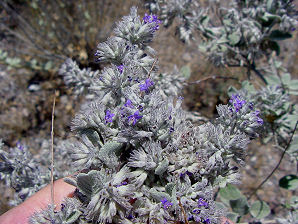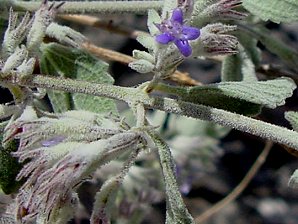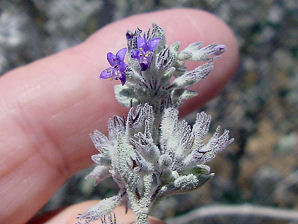Arizona Wild Flowers
Pictures, Photos, Images
Descriptions, Information, Reviews.
Desert Lavender, Hyptis emoryi.
We Are Proud Of Our SafeSurf Rating!
Click On Any Of The Following Links By Amazon.Com
For Books, & Videos About Wildflowers Of Arizona & The Southwest USA. No Obligation!
 |
| Desert Lavender, Hyptis emoryi, Lake Pleasant, May 4, 2005. |
|---|
 |  |
| Desert Lavender, Hyptis emoryi Shrub To 15 Feet. | Mint Family, Labiatae. |
|---|---|
 |  |
| Bees Love This Flower. | Only Species In Arizona Leaves Have Mint Flavor. |
Click On Any Of The Following Links By Amazon.Com
For Books, & Videos About Wildflowers Of Arizona & The Southwest USA. No Obligation!
Desert Lavender.
We wish to thank Wikipedia, the free encyclopedia for some of the information on this page. We share images and information with Wikipedia. Desert lavender is a medium to tall, cold tender, perennial shrub, found in the southwestern United States of Arizona, Nevada, California, and northwestern Mexico in Sonora and Baja California. It is a multi-stemmed perennial shrub reaching 15 � 18 feet in height under optimum conditions. Hyptis emoryi has beautiful violet-blue flowers up to 1 inch, in leaf axils. The flowers are profuse along the main stem and side branches and they have an aromatic attractor to the honeybee and other species of bees. Its leaves are oval with a whitish gray-green- color (under desert conditions), they have serrated margins, they are hairy, and about 2 - 3 inches in length. It is found in dry washes, and on rocky slopes, up to 3000 feet in elevation. It is evergreen or cold deciduous, depending upon its location. It is usually found in areas near a water source; but not always. in the southwestern USA deserts it is commonly in the dry washes, intermixed with other species.
Plants Associated With Desert lavender
In Arizona, it is found from central to southwestern Arizona of the Sonoran Desert; in northwest Arizona it is found in regions of the Mojave Desert. In southern California and Nevada, desert lavender is found in the southern regions of the Mojave Desert and the Colorado Desert of southeast California. Perennial, semi-deciduous to deciduous evergreen shrub with gray bark. The flowers smell like lavender and are attractive to bees. The leaves have a mint flavor. We use this plant at one of our homes in Glendale, Arizona, as a xeriscape, tall shrub.
Quick Notes:
Height: Growing 6 - 8 feet sometimes to about 15 - 18 feet tall
Flowers: The flowers are violet up to 1 inch wide and in clusters.
Flowering Time: January - May.
Leaves: The leaves are gray, ovate simple leaves, up to 3 inches long and 1 inch wide with serrated margins.
Stems: Typical mint family square stems, green - white and covered in woolly hairs.
Found: The USDA claims Hyptis emoryi is native to the southwestern United States (AZ, CA, TX). It is native to Arizona in all counties except; Coconino, Navajo, Apache, Greenlee, Cochise, & Santa Cruz. It is also native to the extreme northwest of Mexico; in the states of Baja Norte, Baja Sur, & Sonora.
Hardiness:
Soil pH requirements:
Sun Exposure:
Elevation: Can be found from 0 - 3,000 Feet.
Habitat: Gravelly or sandy washes , disturbed, or stony soils. One species in Arizona. An ideal xeriscape landscape plant in Arizona.
Miscellaneous: Flowering Photos Taken May 4, 2005. Lake Pleasant, Arizona.
|



We Are Proud Of Our SafeSurf Rating!
Click On Any Of The Following Links By Amazon.Com
For Books, & Videos About Xerioscape Plants Of Arizona & The Southwest USA. No Obligation!
Back To Arizona Wild Flowers Home Page.
Back To Arizona Wild Flowers, Blue - Violet Flowers Page Two.
Back To Arizona Xeriscape Landscaping Main Page.
Back To Xeriscape Shrubs Page Two.
Back To DeLange Home Page
© 1966 - Present, Audrey, Eve, & George DeLange
| © 1966 - Present, Audrey, Eve, & George DeLange |

